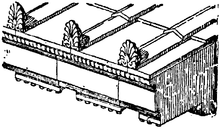Antefix

An antefix (from Latin antefigere, to fasten before) is a vertical block which terminates the covering tiles of the roof of a tiled roof. In grand buildings the face of each stone ante-fix was richly carved, often with the anthemion ornament. In less grand buildings moulded ceramic ante-fixae, usually terracotta, might be decorated with figures or other ornament, especially in the Roman period. By this time they were found on many large buildings, including private houses.

Antefixes in position
Etymology
From Latin antefixa, pl. of antefixum, something fastened in front, from antefixus, fastened in front: ante-, ante- and fixus, fastened, past participle of figere, to fasten.[1]
References
-
 This article incorporates text from a publication now in the public domain: Chisholm, Hugh, ed. (1911). "Ante-fixae". Encyclopædia Britannica (11th ed.). Cambridge University Press.
This article incorporates text from a publication now in the public domain: Chisholm, Hugh, ed. (1911). "Ante-fixae". Encyclopædia Britannica (11th ed.). Cambridge University Press.
External links
 Media related to Antefixes at Wikimedia Commons
Media related to Antefixes at Wikimedia Commons
This article is issued from Wikipedia - version of the 4/21/2016. The text is available under the Creative Commons Attribution/Share Alike but additional terms may apply for the media files.

